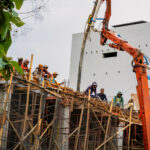Workplace Injuries: California Workers’ Compensation Explained
In the face of workplace injuries, California's workers' compensation system offers essential protection. This article provides a comprehensive understanding of this no-fault insurance, its coverage, and claim filing process. Delve into common work-related injuries, benefits encompassing medical treatment to disability, and rehabilitation services. Armed with this knowledge, employees can confidently navigate the workers' compensation system, ensuring access to rightful benefits while eliminating potential legal complexities.

Key Takeaways
- Workers' compensation insurance protects employees and employers in case of work-related injuries.
- Common work-related injuries include tripping, slipping, falling, and lifting heavy objects.
- California workers' compensation system provides benefits for work-related injuries or illnesses.
- Coverage under California workers' compensation includes medical treatment, death benefits, job retraining, temporary disability, and permanent disability.
Understanding Workers’ Compensation Insurance and Its Benefits
Understanding Workers' Compensation Insurance is crucial for both employers and employees, as it provides vital benefits such as medical treatment coverage and wage replacement in the event of a work-related injury or illness. It is an indispensable tool that ensures workplace safety precautions are taken seriously. This no-fault system operates regardless of who is at fault for an accident, thereby safeguarding employees' rights. The workers' compensation claims process is initiated by reporting the injury to a supervisor promptly, notifying the employer if it is a gradual injury, and informing the doctor that it is work-related. A claim form provided by the employer must be completed and submitted. This detail-oriented procedure, though complex, epitomizes the core of labor laws, offering protection and benefits to all parties involved.
Identifying Common Work-Related Injuries
In the realm of occupational safety, identifying common work-related injuries plays a crucial role in creating safer working environments and preventing future incidents. Knowledge of common causes of workplace injuries helps employers devise effective work-related injury prevention strategies. In California, common injuries include slips, trips, and falls, lifting injuries, musculoskeletal problems such as carpal tunnel syndrome, and injuries from poorly organized workplaces. Workers' rights protected by labor laws and the California Workers' Compensation system extend to these injuries. Ensuring a safe work environment involves understanding these common injuries, their causes, and implementing prevention strategies. These may include ergonomic solutions, safe lifting training, regular office maintenance, and educating employees about potential risks.
The Basics of California Workers’ Compensation
The California Workers' Compensation system, established to protect both full-time and part-time employees, provides five key benefits, namely medical treatment, death benefits, job retraining, temporary disability, and permanent disability, and it operates on a no-fault basis, which means coverage is granted regardless of who is responsible for the injury. To meet the workers' compensation eligibility requirements, an employee must promptly report the injury to their employer. The workers' compensation claim process involves notifying the employer, obtaining a claim form, and submitting the completed form to the employer. It is crucial to keep copies of all related documentation. Understanding this system and its procedures empowers employees to fully exercise their rights under labor laws, ensuring they receive the benefits they are entitled to in the event of a workplace injury.
What Does California Workers’ Compensation Cover
Frequently, California Workers' Compensation covers medical expenses and lost wages due to work-related injuries or illnesses, and it also provides death benefits, job retraining, and disability benefits, whether temporary or permanent. However, limitations of workers' compensation coverage in California exist, excluding certain conditions like stress-induced mental health issues and self-inflicted injuries. Recent changes to California workers' compensation laws have broadened the scope of coverage, including COVID-19 under the presumption of work-related illnesses for certain sectors. Nevertheless, these amendments have been met with controversy and legislative challenges, prompting an ongoing discourse on balancing worker protection and employer responsibilities. Navigating through these legal nuances requires comprehensive understanding of labor laws, demanding vigilance from both workers and employers.
The Process of Filing a Workers’ Compensation Claim
After sustaining a work-related injury, it is essential to promptly report the incident to your supervisor, and then proceed with filling out the provided claim form, ensuring that all necessary documentation is properly submitted to initiate the process of filing a workers' compensation claim. This underscores the importance of timely reporting, which is pivotal in preserving your rights under the labor law. The role of doctors in workers' compensation claims is also crucial; they provide the necessary medical reports that detail the extent of the injury and the required treatment plan. Remember, under California's workers' compensation system, the time constraint for reporting an injury is strictly adhered to, so it's imperative to act swiftly to ensure a smooth claim process.
How to Report Work-Related Injuries to Your Supervisor
In regard to an employee's responsibility, promptly informing your supervisor about a work-related injury is a critical step in the process of securing your workers' compensation benefits. This act is central to the reporting procedures outlined under California labor laws. Effective supervisor communication ensures that the incident is accurately documented, which is crucial in maintaining the integrity of the claim. Notably, the injury must be reported within 30 days to adhere to statutory regulations. Delay or failure to report may result in a denial of benefits. It's advised that employees provide a detailed account of the incident, including date, time, location, nature of the injury, and any potential witnesses. This meticulous approach guarantees a comprehensive record, significantly enhancing the chances of a successful claim.
Understanding Medical Treatment Under Workers’ Compensation
Although workers' compensation provides coverage for medical treatment, it is essential to understand what specific procedures and costs are included to ensure that one maximizes their benefits while receiving appropriate and necessary care. Work-related injuries can significantly impact employee productivity, and navigating the medical treatment aspect of the workers' compensation system can pose challenges. Covered costs typically include doctor visits, medication, surgery, and rehabilitation, yet it is critical to verify the insurer's approval before undertaking any procedure. Moreover, the process of obtaining this approval can be arduous, often requiring extensive documentation and medical evaluations. Therefore, understanding these nuances is crucial not only for accessing deserved benefits but also for maintaining productivity in the face of work-related injuries.
Exploring Disability Benefits: Temporary and Permanent
During the healing period following a work-related injury, temporary disability benefits may be provided to the worker, and if the injury results in permanent loss of physical or mental function, permanent disability benefits may be awarded. Understanding the distinction between temporary and permanent disability benefits is crucial. Temporary disability benefits serve as wage replacement during the worker's recovery period. Conversely, permanent disability benefits are provided when a worker sustains irreversible damage. Eligibility requirements for workers' compensation benefits include timely reporting of the injury and medical verification of the work-related disability. Navigating this complex legal landscape requires a firm grasp of labor law terminology and procedures to ensure the rights of the injured worker are fully protected.
Death Benefits and Dependents: What You Need to Know
Under the umbrella of California's workers' compensation system, death benefits are provided for the dependents of workers who tragically lose their lives due to work-related accidents or illnesses. This provision is a fundamental aspect of labor law, offering crucial financial support in the wake of a devastating event. The eligibility requirements are straightforward: the deceased must have been an employee who died due to a work-related cause, and the claimant must be a dependent. Documentation must be meticulously presented, including death certificates and evidence of dependency. The death benefits aim to alleviate financial hardship, catering to funeral expenses, lost income, and ongoing living costs. This highlights the importance of understanding and exercising workers' rights within the parameters of the workers' compensation system.
Retraining and Rehabilitation Services Under Workers’ Compensation
How do retraining and rehabilitation services function within the scope of California's workers' compensation system, and what benefits do these services provide to injured employees unable to return to their previous job roles? Retraining and rehabilitation services are critical aspects of California's workers' compensation system. In cases where employees cannot resume their prior roles due to sustained injuries, these services offer a lifeline. Vocational rehabilitation services, for instance, equip employees with new skills, thereby enhancing their employability in different fields. On the other hand, retraining benefits facilitate this transition, covering costs associated with acquiring new skills. This approach ensures workers are not disadvantaged by work-related injuries, underlining the system's commitment to safeguarding workers' rights and maintaining a productive workforce.
Frequently Asked Questions
How Does the California Workers’ Compensation System Differ From Other States?
The California workers' compensation system differs from other states in several aspects. Notably, it provides five types of benefits: medical treatment, temporary disability, permanent disability, supplemental job displacement, and death benefits. Furthermore, California is unique in offering a 'no-fault' system, ensuring coverage irrespective of who caused the work-related injury. These state-specific benefits and the structure of the compensation system make California's approach distinct in the landscape of workers' compensation across the United States.
What Legal Rights Do Employees Have if Their Workers’ Compensation Claims Are Denied?
If an employee's workers' compensation claim is denied in California, they have the legal right to challenge the decision through an appeal process. This process involves filing an application for adjudication with the Workers' Compensation Appeals Board. It's recommended employees seek legal representation to navigate this complex process. An experienced attorney can guide the employee, ensuring they understand their rights, the necessary procedures, and can effectively advocate for their entitlements under California's labor laws.
Are Independent Contractors Eligible for California Workers’ Compensation Benefits?
In California, independent contractors are generally not eligible for workers' compensation benefits. Contractor classification challenges arise when workers are misclassified as independent contractors rather than employees. This has significant implications for the gig economy, where many workers operate as independent contractors. Misclassified employees can pursue legal recourse to obtain entitled workers' compensation benefits. Therefore, correctly determining worker status is crucial in the context of workers' compensation.
Can Workers Receive Compensation if the Injury Was Partially Their Fault?
In California's workers' compensation system, the principle of 'no-fault' applies, meaning benefits are provided regardless of who is responsible for the injury. Therefore, even if the worker was partially at fault, they can still receive compensation. The key factor is that the injury occurred in the course of employment. Fault determination does not typically impact benefit entitlement, but the degree of injury impact can influence the amount of compensation provided.
What Are the Consequences for Employers Who Do Not Provide Workers’ Compensation Insurance in California?
In California, employers not providing workers' compensation insurance face severe penalties. They may be charged with a misdemeanor punishable by imprisonment in county jail up to one year, or by a fine up to $10,000, or both. Moreover, the state may issue a stop order against the business, effectively prohibiting further operation until insurance is secured. These penalties highlight the serious obligation employers have to provide insurance or viable alternatives for their employees' work-related injuries.
Conclusion
In summary, California's workers' compensation system plays a critical role in safeguarding workers' rights and health, offering a range of benefits, from medical care to disability payments. Familiarity with the process of filing a claim and understanding the types of available benefits allows employees to navigate this system effectively. Therefore, a comprehensive understanding of this no-fault insurance system is vital for both employees and employers in the context of labor law and workplace health and safety.

This post has been generated by AI and was not reviewed by editors. This is Not legal advice. Please consult with an attorney.




